michalJenco
Hazard to Self
 
Posts: 50
Registered: 7-2-2019
Member Is Offline
|
|
Procedure for Coumarin - different product, what is it?
Hi chemists,
I tried to make coumarin using the apparently classic method of salicylaldehyde + acetic anhydride + sodium acetate. However, I wanted to use little Ac2O and
found a procedure using acetic acid instead of the anhydride with a 10% yield. So the mixture I used is this:
- 117g salicylaldehyde
- 105g acetic acid
- 70g sodium acetate
- 50g Ac2O
I refluxed for 5h30m (reflux temperature was 162-165 °C the whole time), let cool and solidify overnight, dissolved in a lot of water.
There formed a bottom layer having almost the same volume as the starting salicylaldehyde, smelling the same, having orange color. I stirred this with
aqueous Na2SO3 to form an adduct with the unconsumed salicylaldehyde (as stated in a procedure from 1953). That didn't seem to decrease volume of the
salicylaldehyde, so I switched to K2S2O5 (found in some discussion on this site to also work). That worked and I was left with bits of orange solids.
I then added ether which dissolved them. I then washed the ether with water, dried with CaCl2 and evaporated off to leave this.
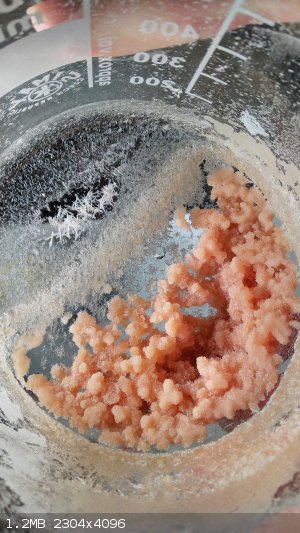
I then heated this with 40g of NaOH in ~400mL of water. which was supposed to dissolve the solids, but it didn't really. I then acidified with HCl to
just a few drops from being acidic to keep a bit of remaining salicylaldehyde in solution.
I filtered the solids and recrystallized from boiling isopropylalcohol, which was hot-filtered to remove undissolved stuff. It crystallized rapidly
into long sharp crystals.
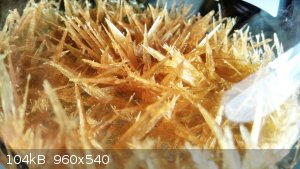
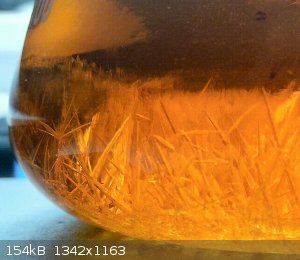
This was then vacuum filtered, washed with ice-cold isopropylalcohol and then few times with r.t. methanol just to for it to dry quicker. Dried
product:
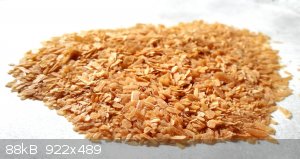
The m.p. is, however, 117-119 °C, not the expected 71. Also it doesn't smell at all (should be vanilla-like) and has no taste (should be bitter, and
I only tried a trace amount).
One idea I have is it could be 3-acetylcoumarin, which matches the m.p. almost perfectly. The yield would be 7.5% if this is the product btw.
Could the acetic acid/Ac2O mixture acetylate the coumarin in your opinion?
[Edited on 10-3-2020 by michalJenco]
[Edited on 11-3-2020 by michalJenco]
|
|
|
michalJenco
Hazard to Self
 
Posts: 50
Registered: 7-2-2019
Member Is Offline
|
|
Still nobody has any idea?
|
|
|
mackolol
Hazard to Others
  
Posts: 459
Registered: 26-10-2017
Member Is Offline
Mood: Funky
|
|
All I have done in my life that is anywhere close to coumarin is umbelliferone - 7hydroxycoumarin. I don't know what do you need the coumarin for, but
this may be substitute. It's made easily from resorcinol and malic acid on heating with H2SO4.
Was the acetic acid anhydrous (glacial)?
|
|
|
Fery
International Hazard
    
Posts: 1055
Registered: 27-8-2019
Location: Czechoslovakia
Member Is Offline
|
|
Don't wash with NaOH as it splits the lactone ring. I'm currently performing the synthesis, just at smaller scale than you (1/10).
Experiment 4.7.7.2 uses Na2CO3 instead of NaOH and there is a control question 4.7.7.2.11 (4) at the end of the experiment as this is educational
material from pharmaceutical faculty, why not to use NaOH (Why is coumarin soluble in solutions of alkali hydroxide?) and is available here:
https://www.pdfdrive.com/advanced-practical-medicinal-chemis...
https://www.pdfdrive.com/download.pdf?id=41004348&h=ebab...
And some reading according the mechanism here:
https://sci-hub.tw/https://doi.org/10.1039/JR9530003435
Surprisingly the mechanism is different when you react benzaldehyde instead of salicylaldehyde with acetic anhydride using basic catalyst Na acetate.
With benzaldehyde you produce trans cinnamic acid which wouldn't cyclisize - recently I posted my experiment https://www.sciencemadness.org/whisper/viewthread.php?tid=12...
With salicylaldehyde the first step is reaction of -OH group of salicylaldehyde with acetic anhydride (similarly as when you synthesize
acetylsalicylic acid).
There is also stated that for 1 mole of the product you need 2 moles of acetic anhydride to have good yield 45% and not only poor
10%...
I'm using salicylaldehyde : acetic anhydride in 1 : 2,5 molar ratio as stated in the source from pharmaceutical faculty. But I have to finish the
experiment, so my results will be in few days (yield, m.p.).
The product should have vanilla scent. I encounter warfarine administration in my job sometimes, it is substituted coumarin. Interestingly the plane
coumarin does not have anticoagulant properties. But dicoumarin has them and also some of coumarin derivates. Dicoumaryl is present in moldy silage
made from sweet clover and anticoagulant properties were discovered in mouldy wet sweet-clover hay, as the cause of a naturally occurring bleeding
disease in cattle. For some time we already have never generation of anticoagulants available (NOAH, non-vitamin K antagonist oral anticoagulants) but
they are not derivates of coumarin.
Till today I had information only about warfarin + NOAH and now I'm somewhat slightly better educated 
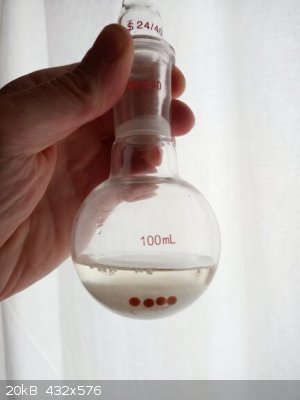 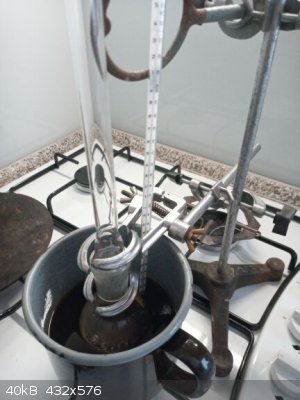
|
|
|
Pumukli
National Hazard
   
Posts: 708
Registered: 2-3-2014
Location: EU
Member Is Offline
Mood: No Mood
|
|
Vanilla scent? No way!
Coumarine has ummm... coumarine scent!
Don't expect vanilla scent, pure coumarine smells wonderfully different from that. It has a very pleasant smell, I can't compare it to anything,
surely not to vanilla. It is colourless (white) and forms nice, 2-3 mm flat square-like crystalls. At least my sample looks like this.
4-OH-coumarine - the building block of anticoagulant rodenticides is odourless as far as I remember.
|
|
|
Fery
International Hazard
    
Posts: 1055
Registered: 27-8-2019
Location: Czechoslovakia
Member Is Offline
|
|
Hi Pumukli, you are right, vanilla scent is only public shared info, real experience is better than thousands of words.
I finished the 4.7.7.2.5 from the book in the link I posted and my yield is only 3,0 g vs. 4,3 g in the book, but approx 1 g may be still staying in
mother liquor (350 ml) so perhaps I'll recover some of it. I also do not know how old is my salicylaldehyde and how pure, it was a sale-out item of
not completely full bottle.
You are right, the scent is unique. Yes very pleasant. My yet unpurified crystals are almost colorless, cotton like, but I will have to perform
recrystallization (4.7.7.2.7) - I hope it is coumarin and not something else, m.p. after recrystallization will tell the truth 
Coumarines are not only rodents poisons but small doses (approx 2-5 mg of warfarin per day) are used for treat people with tromboemboly, deep
flebotrombosis etc for few months. Blood plasma must be regularly checked and value of INR determined which must be in range 2-3. Vitamin K is
warfarin antidotum but slow, if quick antidotum necessary then human plasma transfer. People taking warfarin pills must keep a diet low on vitamin K
or eat every day the same amount of vitamin K in vegetables, otherwise the value of INR would undergo rapid changes outside the therapeutical range.
That's why NOAH were developed where no need to periodically check INR in blood, but these NOAH medicals are very expensive in comparison with cheap
old good warfarin. And there are some diseases or complications where the warfarine is the preferred choice. There is an antibiotic
trimetoprim+sulfamethoxazol which also antagonise vitamin K effect.
The unsubstituted coumarin I've synthesized lacks anticoagulant properties, I just wanted to know its scent.
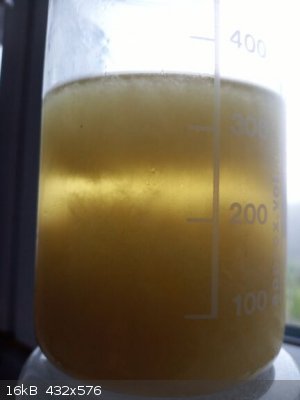 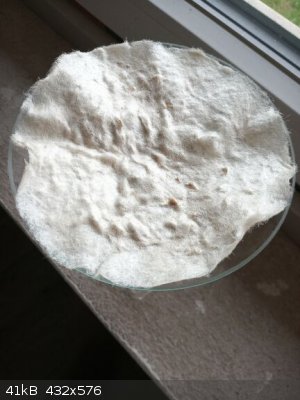
|
|
|
Fery
International Hazard
    
Posts: 1055
Registered: 27-8-2019
Location: Czechoslovakia
Member Is Offline
|
|
I did not obtain that flat square-like crystals when recrystallizing from water. Too much water = cotton like crystals. Less water (recrystallization
by the method in the chapter 4.7.7.2.7 in the pdf) = leaves-like crystals (on cooling down first milky emulsion, later crystallization). Perhaps
different solvent necessary for the shape as Pumukli wrote (also different sources state the same crystals shape as Pumukli).
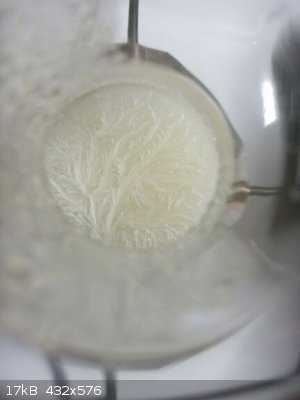
|
|
|